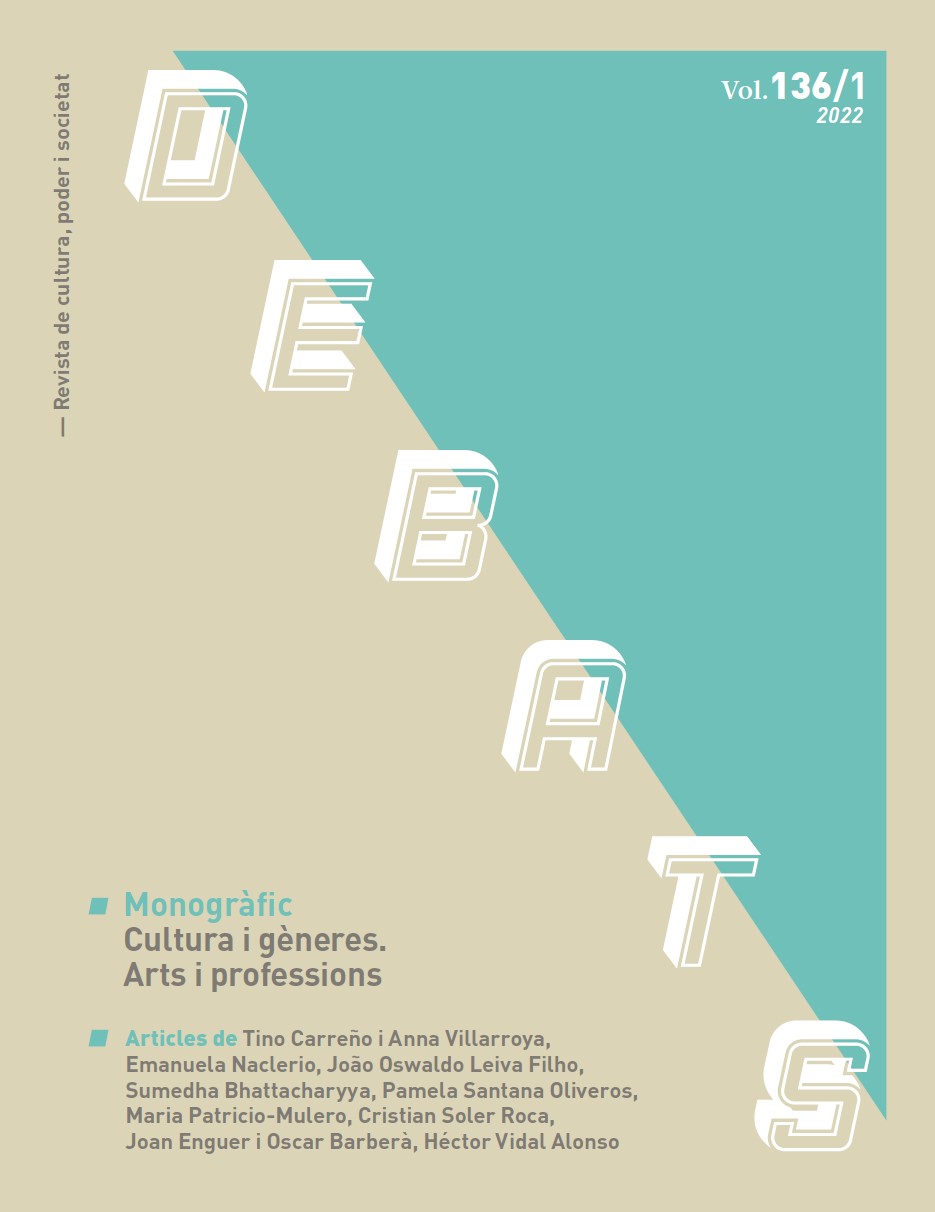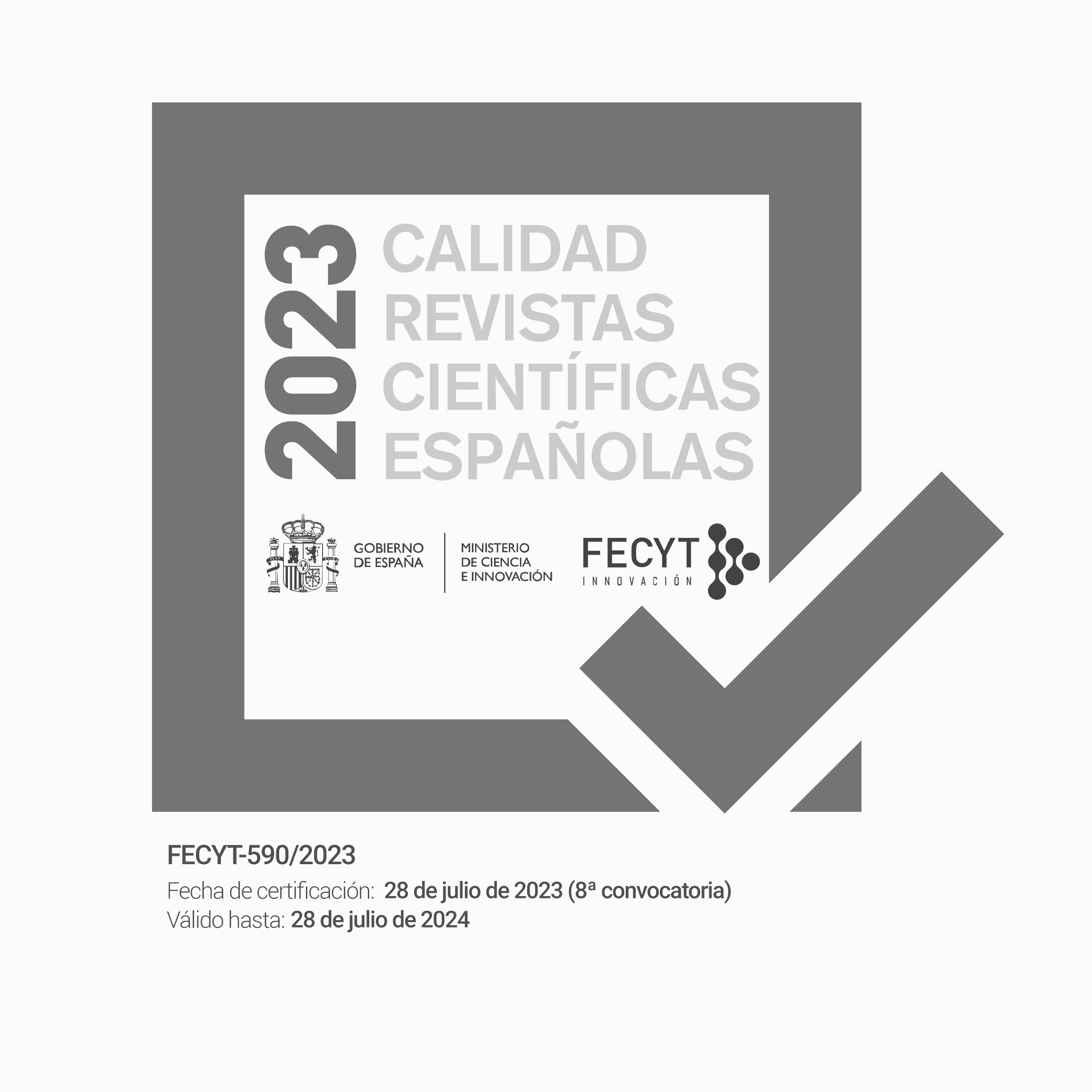Actrices jóvenes en el entorno laboral: un análisis de las desigualdades de género y poder en el sector teatral italiano
DOI:
https://doi.org/10.28939/iam.debats-136-1.2Palabras clave:
gender, cultural work, theatreResumen
Desde que se levantara la prohibición de la participación de las mujeres en las obras de teatro, a mediados del siglo xvii en Inglaterra, hasta el impacto comunicativo de la campaña #MeToo, la presencia de las actrices en el escenario siempre ha servido para cuestionar y reducir profundamente las normas sociales relacionadas con el género y el espacio cultural. Utilizando una metodología cualitativa, este artículo analiza las experiencias de trabajo de jóvenes actrices en el sector de las artes escénicas italianas, considerando aspectos estéticos y emocionales relacionados con el trabajo teatral. El entorno ocupacional, descrito a través de conjuntos de datos y encuestas específicas del sector, parece estar caracterizado por marcadas asimetrías de poder en términos de edad y género que, a su vez, están incrustadas en las experiencias laborales cotidianas, corporales y emocionales de las jóvenes actrices.
Descargas
Citas
Acker, J. (1992). From Sex Roles to Gendered Institutions. Contemporary Sociology, 21(5), 565. https://doi.org/
2307/2075528
Acker, J. (2006). Inequality Regimes. Gender & Society, 20(4), 441–464. https://doi.org/10.1177/0891243206289499
Adkins, L. (1999). Community and Economy: A Retraditionalization of Gender? Theory, Culture & Society, 16(1), 119–139.
https://doi.org/10.1177/026327699016001008
Alacovska, A. (2018). Informal creative labour practices: A relational work perspective. Human Relations, 71(12), 1563–1589.
https://doi.org/10.1177/0018726718754991
Ambrosetti, E., i Cela, E. (2015). Demography of Race and Ethnicity in Italy. En R. Sáenz, D. G. Embrick, i N. P.
Rodríguez (ed.), The International Handbook of the Demography of Race and Ethnicity (p. 457–482). Springer
Netherlands. https://doi.org/10.1007/978-90-481-8891-8_22
Armano, E., i Murgia, A. (2013). The precariousnesses of young knowledge workers: A subject-oriented approach.
Global Discourse, 3(3), 486–501. https://doi.org/10.1080/23269995.2013.865313
Armano, E., i Murgia, A. (2017). Hybrid areas of work in Italy. Mapping Precariousness, Labour Insecurity and Uncertain
Livelihoods (p. 47–59). Routledge. https://doi.org/10.4324/9781315593838-5
Arvidsson, A., Malossi, G., i Naro, S. (2010). Passionate Work? Labour Conditions in the Milan Fashion Industry.
Journal for Cultural Research, 14(3), 295–309. https://doi.org/10.1080/14797581003791503
Ashton, D. (2021). Cultural organisations and the emotional labour of becoming entrepreneurial. Poetics. https://
doi.org/10.1016/j.poetic.2021.101534
Bain, A. (2004). Female artistic identity in place: The studio. Social & Cultural Geography, 5(2), 171–193. https://doi.
org/10.1080/14649360410001690204
Banks, M., i Milestone, K. (2011). Individualization, Gender andAcker, J. (1992). From Sex Roles to Gendered Institutions. Contemporary Sociology, 21(5), 565. https://doi.org/
2307/2075528
Acker, J. (2006). Inequality Regimes. Gender & Society, 20(4), 441–464. https://doi.org/10.1177/0891243206289499
Adkins, L. (1999). Community and Economy: A Retraditionalization of Gender? Theory, Culture & Society, 16(1), 119–139.
https://doi.org/10.1177/026327699016001008
Alacovska, A. (2018). Informal creative labour practices: A relational work perspective. Human Relations, 71(12), 1563–1589.
https://doi.org/10.1177/0018726718754991
Ambrosetti, E., i Cela, E. (2015). Demography of Race and Ethnicity in Italy. En R. Sáenz, D. G. Embrick, i N. P.
Rodríguez (ed.), The International Handbook of the Demography of Race and Ethnicity (p. 457–482). Springer
Netherlands. https://doi.org/10.1007/978-90-481-8891-8_22
Armano, E., i Murgia, A. (2013). The precariousnesses of young knowledge workers: A subject-oriented approach.
Global Discourse, 3(3), 486–501. https://doi.org/10.1080/23269995.2013.865313
Armano, E., i Murgia, A. (2017). Hybrid areas of work in Italy. Mapping Precariousness, Labour Insecurity and Uncertain
Livelihoods (p. 47–59). Routledge. https://doi.org/10.4324/9781315593838-5
Arvidsson, A., Malossi, G., i Naro, S. (2010). Passionate Work? Labour Conditions in the Milan Fashion Industry.
Journal for Cultural Research, 14(3), 295–309. https://doi.org/10.1080/14797581003791503
Ashton, D. (2021). Cultural organisations and the emotional labour of becoming entrepreneurial. Poetics. https://
doi.org/10.1016/j.poetic.2021.101534
Bain, A. (2004). Female artistic identity in place: The studio. Social & Cultural Geography, 5(2), 171–193. https://doi.
org/10.1080/14649360410001690204
Banks, M., i Milestone, K. (2011). Individualization, Gender andAcker, J. (1992). From Sex Roles to Gendered Institutions. Contemporary Sociology, 21(5), 565. https://doi.org/
2307/2075528
Acker, J. (2006). Inequality Regimes. Gender & Society, 20(4), 441–464. https://doi.org/10.1177/0891243206289499
Adkins, L. (1999). Community and Economy: A Retraditionalization of Gender? Theory, Culture & Society, 16(1), 119–139.
https://doi.org/10.1177/026327699016001008
Alacovska, A. (2018). Informal creative labour practices: A relational work perspective. Human Relations, 71(12), 1563–1589.
https://doi.org/10.1177/0018726718754991
Ambrosetti, E., i Cela, E. (2015). Demography of Race and Ethnicity in Italy. En R. Sáenz, D. G. Embrick, i N. P.
Rodríguez (ed.), The International Handbook of the Demography of Race and Ethnicity (p. 457–482). Springer
Netherlands. https://doi.org/10.1007/978-90-481-8891-8_22
Armano, E., i Murgia, A. (2013). The precariousnesses of young knowledge workers: A subject-oriented approach.
Global Discourse, 3(3), 486–501. https://doi.org/10.1080/23269995.2013.865313
Armano, E., i Murgia, A. (2017). Hybrid areas of work in Italy. Mapping Precariousness, Labour Insecurity and Uncertain
Livelihoods (p. 47–59). Routledge. https://doi.org/10.4324/9781315593838-5
Arvidsson, A., Malossi, G., i Naro, S. (2010). Passionate Work? Labour Conditions in the Milan Fashion Industry.
Journal for Cultural Research, 14(3), 295–309. https://doi.org/10.1080/14797581003791503
Ashton, D. (2021). Cultural organisations and the emotional labour of becoming entrepreneurial. Poetics. https://doi.org/10.1016/j.poetic.2021.101534
Bain, A. (2004). Female artistic identity in place: The studio. Social & Cultural Geography, 5(2), 171–193. https://doi.
org/10.1080/14649360410001690204
Banks, M., i Milestone, K. (2011). Individualization, Gender and Cultural Work. Gender, Work & Organization, 18(1), 73–89. https://doi.org/10.1111/j.1468-0432.2010.00535.x
Barrios, M., i Villarroya, A. (2021). What is needed to promote gender equality in the cultural sector? Responses
from cultural professionals in Catalonia. European Journal of Cultural Studies, 1–20. https://doi.org/10.1177/
Bartky, S. L. (2015). Femininity and domination: Studies in the phenomenology of oppression. Routledge.
Bataille, P., Casula, C., Bertolini, S., i Perrenoud, M. (2020). From atypical to paradigmatic? Artistic work in
contemporary capitalist societies. Sociologia Del Lavoro, 157(2). https://doi.org/10.13140/RG.2.2.32829.49126
Beck, U. (1992). Risk society: Towards a new modernity (Vol. 17). SAGE Publications Inc.
Bertolini, S. (2010). Genere e precarietà tra lavoro e famiglia: Percezioni, aspettative e strategie delle giovani donne.
Autonomie locali e servizi sociali, 1, 79–92. https://doi.org/10.1447/32395
Bertolini, S., i Luciano, A. (ed.) (2011). Incontri dietro le quinte: Imprese e professionisti nel settore dello spettacolo. Il
Mulino. https://www.mulino.it/isbn/9788815150127
Bertolini, S., Moiso, V., i Unt, M. (2019). Precarious and creative: Youth facing uncertainty in the labour market.
En Youth and the Politics of the Present: Coping with Complexity and Ambivalence. Routledge.
Bertolini, S., i Vallero, M. (2011). “Io non faccio la ballerina, io sono una ballerina”. Tra successo e abbandono: I
percorsi di carriera nei settori artistici. Sociologia del lavoro, 123, 207–229. https://doi.org/10.3280/SL2011-123013
Bonomi, A. (2012). Milano: Le tre città che stanno in una. Mondadori.
Bozzon, R. (2008). Modelli di partecipazione delle donne al mercato del lavoro. Un’applicazione dell’analisi delle
sequenze alle storie lavorative femminili. Stato e mercato, 2, 217–250. https://doi.org/10.1425/27523
Bruni, A., Gherardi, S., i Poggio, B. (2004). Doing Gender, Doing Entrepreneurship: An Ethnographic Account
of Intertwined Practices. Gender, Work and Organization, 11(4), 406–429. https://doi.org/10.1111/j.1468-
2004.00240.x
Butler, J. (1990). Gender Trouble: Feminism and the Subversion of Identity. Routledge. https://philpapers.org/rec/BUTGTF
Calbi, A. (ed.). (2011). Milano. Città e spettacolo. Teatro danza musica cinema e dintorni. Sassi.
Casula, C. (2019). Gender and the Classical Music World: The unaccomplished professionalization of women in
Italy. Per Musi, 39, 1–24. https://doi.org/10.35699/2317-6377.2019.5270
Charmaz, K., i Belgrave, L. (2012). Qualitative interviewing and grounded theory analysis. En J. F. Gubrium, J. A.
Holstein, A. B. Marvasti, i K. D. McKinney (ed.), The SAGE handbook of interview research: The complexity of the
craft (Vol. 2, p. 347–365). Sage Thousand Oaks, California.
Colbert, F. (2005). The Piccolo Teatro of Milan: Theatre of Europe. International Journal of Arts Management, 7(3), 66–73.
Comunian, R., i England, L. (2020). Creative and cultural work without filters: Covid-19 and exposed precarity in
the creative economy. Cultural Trends, 29(2), 112–128. https://doi.org/10.1080/09548963.2020.1770577
Conor, B., Gill, R., i Taylor, S. (2015). Gender and Creative Labour. The Sociological Review, 63(1_suppl), 1–22. https://
doi.org/10.1111/1467-954X.12237
Crossley, N. (1996). Body-Subject/Body-Power: Agency, Inscription and Control in Foucault and Merleau-Ponty.
Body & Society, 2(2), 99–116. https://doi.org/10.1177/1357034X96002002006
Csordas, T. J. (1990). Embodiment as a Paradigm for Anthropology. Ethos, 18(1), 5–47. https://doi.org/10.1525/
eth.1990.18.1.02a00010
D’Ovidio, M., i Cossu, A. (2017). Culture is reclaiming the creative city: The case of Macao in Milan, Italy. City,
Culture and Society, 8, 7–12. https://doi.org/10.1016/j.ccs.2016.04.001
Davis, T. C. (2002). Actresses as working women: Their social identity in Victorian culture. Routledge.
Dean, D. (2005). Recruiting a self. Work, Employment and Society, 19(4), 14. https://doi.org/DOI: 10.1177/0950017005058061
Dean, D. (2008). No human resource is an island: Gendered, racialized access to work as a performer. Gender, Work
and Organization, 15(2), 161–181. https://doi.org/10.1111/j.1468-0432.2007.00389.x
Di Nunzio, D., Ferrucci, G., i Toscano, E. (2017). Vita da artisti: Ricerca nazionale sulle condizioni di vita e di lavoro dei
professionisti dello spettacolo. Fondazione Di Vittorio and SLC-CGIL.
Donovan, R. (2019). ‘Must Be Heavyset’: Casting Women, Fat Stigma, and Broadway Bodies. The Journal of American
Drama and Theatre, 31(3). https://academicworks.cuny.edu/gc_pubs/539
Elias, A., Gill, R., i Scharff, C. (2017). Aesthetic Labour: Beauty Politics in Neoliberalism. Palgrave Macmillan UK. https://
doi.org/10.1057/978-1-137-47765-1_1
Entwistle, J., i Wissinger, E. (2006). Keeping up Appearances: Aesthetic Labour in the Fashion Modelling Industries of
London and New York. The Sociological Review, 54(4), 774–794. https://doi.org/10.1111/j.1467-954X.2006.00671.x
Ferrazza, F. (ed.). (2019). Relazione sull’utilizzazione del Fondo Unico per lo Spettacolo e sull’andamento complessivo dello
spettacolo (p. 284). MiBACT - Ministero per i Beni e le Attività Culturali e per il Turismo.
Florida, R. L. (2002). The rise of the creative class: And how it’s transforming work, leisure, community and everyday life.
Basic Books.
Fraisse, G. (2000). Les deux gouvernements: La famille et la Cité. Gallimard Paris.
Friedman, S., O’Brien, D., i Laurison, D. (2017). ‘Like Skydiving without a Parachute’: How Class Origin Shapes
Occupational Trajectories in British Acting. Sociology, 51(5), 992–1010. https://doi.org/10.1177/0038038516629917
Gallina, M. (2013). Le organizzazioni culturali di fronte alla crisi: Enti teatrali, musicali, di produzione e promozione
d’arte contemporanea e audiovisuale (Núm.10; Quaderni dell’osservatorio). Fondazione Cariplo. https://doi.
org/10.4460/2013quaderno10
Gallina, M., Monti, L., i Ponte di Pino, O. (ed.) (2018). Attore... Ma di lavoro cosa fai? Occupazione, diritti, welfare
nello spettacolo dal vivo. Franco Angeli.
Gandini, A. (2015). Il lavoro freelance: Reputazione e capitale sociale nell’era del “lavoro digitale”. Quaderni Di
Sociologia, 69, 87–106. https://doi.org/10.4000/qds.522
Gherardi, S. (1995). Gender, symbolism and organizational cultures. Sage.
Gill, R. (2002). Cool, Creative and Egalitarian? Exploring Gender in Project-Based New Media Work in Euro.
Information, Communication & Society, 5(1), 70–89. https://doi.org/10.1080/13691180110117668
Gill, R. (2014). Unspeakable Inequalities: Post Feminism, Entrepreneurial Subjectivity, and the Repudiation of
Sexism among Cultural Workers. Social Politics: International Studies in Gender, State & Society, 21(4), 509–528.
https://doi.org/10.1093/sp/jxu016
Goffman, E. (1979). Gender advertisements (1st Harper colophon ed). Harper & Row.
Grindstaff, L. (2002). The money shot: Trash, class, and the making of TV talk shows. University of Chicago Press.
Grosz, E. A. (1994). Volatile bodies: Toward a corporeal feminism. Indiana University Press.
Grugulis, I., i Vincent, S. (2009). Whose skill is it anyway?: ‘Soft’ skills and polarization. Work, Employment and
Society, 23(4), 597–615. https://doi.org/10.1177/0950017009344862
Hakim, C. (1991). Grateful slaves and self-made women: Fact and fantasy in women’s work orientations. European
Sociological Review, 7(2), 101–121. https://doi.org/10.1093/oxfordjournals.esr.a036590
Hennekam, S., i Bennett, D. (2017). Sexual Harassment in the Creative Industries: Tolerance, Culture and the Need
for Change: Sexual harassment in the creative industries. Gender, Work & Organization, 24(4), 417–434. https://
doi.org/10.1111/gwao.12176
Hesmondhalgh, D., i Baker, S. (2008). Creative Work and Emotional Labour in the Television Industry. Theory,
Culture & Society, 25(7–8), 97–118. https://doi.org/10.1177/0263276408097798
Hochschild, A. R. (1979). Emotion Work, Feeling Rules, and Social Structure. American Journal of Sociology, 85(3),
–575.
Hochschild, A. R. (1983). The managed heart. University of California Press.
Holla, S. (2016). Justifying Aesthetic Labor: How Fashion Models Enact Coherent Selves. Journal of Contemporary
Ethnography, 45(4), 474–500. https://doi.org/10.1177/0891241615575067
Holla, S. (2020). Food in fashion modelling: Eating as an aesthetic and moral practice. Ethnography, 21(1), 26–47.
https://doi.org/10.1177/1466138118769914
Kessler, S. J., i McKenna, W. (1985). Gender: An ethnomethodological approach. University of Chicago Press.
Locatelli, S. (2015). Teatro Pubblico Servizio? Studi sui primordi del Piccolo Teatro e sul sistema teatrale italiano. lulu.com.
McRobbie, A. (2002). From Holloway to Hollywood: Happiness at Work in the New Cultural Economy? En Cultural
Economy: Cultural Analysis and Commercial Life Cultural economy: Cultural analysis and commercial life (p. 97–114).
SAGE Publications Ltd. https://doi.org/10.4135/9781446218440.n6
Descargas
Publicado
Cómo citar
Número
Sección
Licencia
Sin perjuicio de lo dispuesto en el artículo 52 de la Ley 22/1987 de 11 de noviembre de Propiedad Intelectual, BOE del 17 de noviembre de 1987, y conforme al mismo, los autores o autoras ceden a título gratuito sus derechos de edición, publicación, distribución y venta sobre el artículo, para que sea publicado en Debats. Revista de cultura, poder y sociedad.
Debats. Revista de cultura, poder y sociedad se publica bajo el sistema de licencias Creative Commons según la modalidad «Reconocimiento - NoComercial (by-nc): Se permite la generación de obras derivadas siempre que no se haga un uso comercial. Tampoco se puede utilizar la obra original con finalidades comerciales».
Así, cuando el autor o autora envía su colaboración, acepta explícitamente esta cesión de derechos de edición y de publicación. Igualmente autoriza a Debats. Revista de cultura, poder y sociedad, la inclusión de su trabajo en un fascículo de la revista para que se pueda distribuir y vender.











